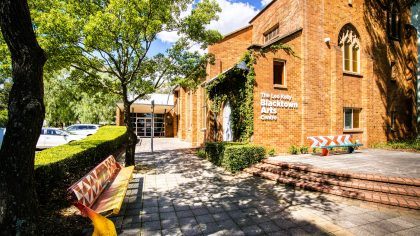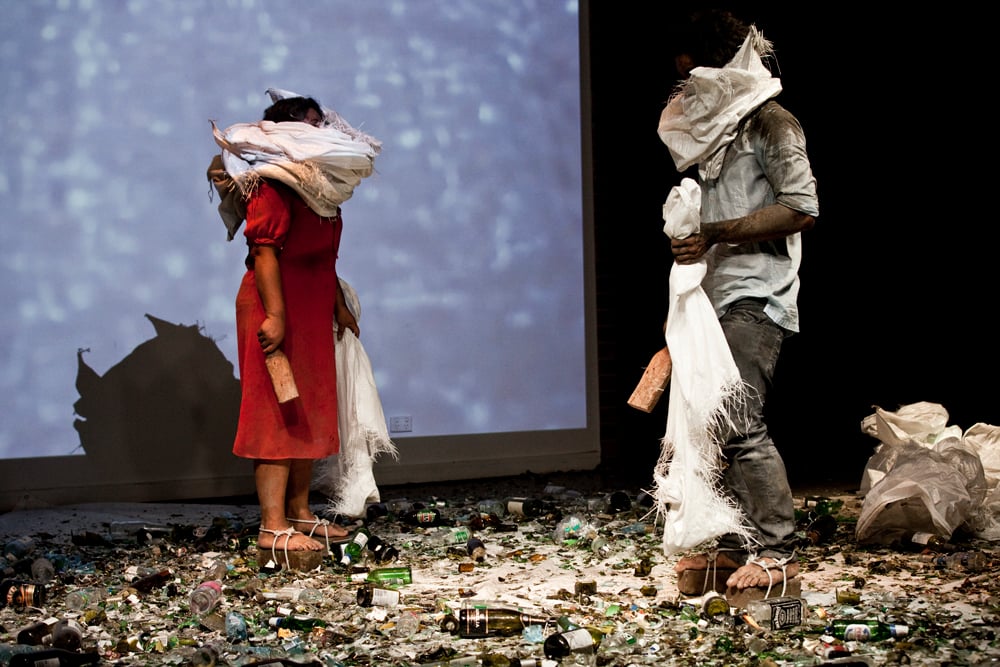
The Leo Kelly Blacktown Arts Centre
An innovative multi-arts hub in the heart of Blacktown City.
Bayadyinyang budyari Dharug yiyura Dharug Ngurra.
Bayady’u budyari Dharug Warunggadgu baranyiin barribugu.
Bayady’u budyari wagulgu yiyuragu Ngurra bimalgu Blacktown City. Flannel flowers dyurali bulbuwul.
Yanmannyang mudayi Dharug Ngurrawa. Walama ngyini budbud dali Dharug Ngurra Dharug yiyura baranyiin barribugu.
We acknowledge the Traditional Custodians of this Land, the Dharug people, and their continued connection to Country.
We pay our respects to Elders from yesterday to tomorrow.
We extend that respect to all Aboriginal and Torres Strait Islander Peoples of Blacktown City where the flannel flowers still grow proud and strong.
We will walk softly on this land and open our hearts to Country as the Dharug people have for tens of thousands of years.
Credit to: Dharug woman Rhiannon Wright, daughter of Leanne ‘Mulgo’ Watson Redpath and granddaughter of Aunty Edna Watson

In August 2014, artist-provocateur Latai Taumoepeau and co-curator Paschal Daantos Berry presented Stitching (Up) The Sea, a season of performative events which transversed the extremities of traditional and contemporary practice, and explored how culture is passed down, exhibited, shared and remembered.
Two years later, as Latai Taumoepeau prepares to take the performance to London for the Spill Festival of Performance and Sacred: Homelands Live Art Festival, she and her co-curator reflect on the intention and impact of that rigorous season with dancer and choreographer Martin del Amo.
Martin del Amo If you could, for a moment, try and cast back your minds to the conversations we had almost two years ago, before Stitching (Up) the Sea actually took place. What were you both thinking? What were the plans? The expectations?
Paschal Daantos Berry I think the initial idea was looking at Blacktown Arts Centre itself and the Stitching the Sea programming as curated by Paul Howard [Visual Arts Curator]. Its aim was to engage Pacific Islander visual artists into looking at how their culture informs their practice. And then, within the performance program, I felt that if we were to throw that provocation to a bunch of artists, that we really needed to look at the context of how our building was made, its own history.
The curatorial core that I had was looking at the church [the building housing what is now Blacktown Arts Centre was originally an Anglican church] and what that actually means to the very diverse Pacific Islander communities that are within the Blacktown Local Government Area. So, we really began with the idea that it was a place that we would open to a “congregation”. We even called it a “congregation of cultures”.
So, it really came from that simple idea to open the doors. If you are looking at a community that has been colonised by so many structures, how do you decolonise the experience, within a very colonising space like an art gallery, and before that a church?
MdA And your choice to include a practicing artist in the curatorial aspect of that?
PDB It was very important for me to involve someone like Latai whose practice is very much informed by culture. To have someone work with me who really understood the extremities of traditional and contemporary practice. To resist a timeline that made a distinction between the traditional and the contemporary. I think Latai and I shared the same opinion that culture is very much moving, and it’s moving at a rapid pace, and that often there is no distinction between what is traditional and contemporary practice.
MdA For you Latai, within the conceptual framing of the project, how does your practice sit within that? Did you feel you could expand on it and take it into different territories?
Latai Taumoepeau Being invited to work with Paschal to co-curate with him is really an interesting way to look at my practice and also a community’s practice from a physical space perspective – looking at the Arts Centre
For me, it was really exciting to think about deconstructing as well as constructing at the same time. It asked some very bold questions, and pushed me to think more about the complexity of what it means to gather physically and why you would do that. There are some simple answers to that, but at the same time there are a lot of things we don’t know about what it is to make one’s body available to a space and for a space to be available to those bodies and that became a really fragile thing to look at. I felt it was in line with my practice but also an opportunity to be a lot deeper in thinking about what I might consider when thinking about other bodies and not just my own.
MdA What was interesting about your curatorial premise was that you were both very strongly involved in the programmed events. You were, in fact, hosting many of them. For me, that sort of involvement felt like you were practically curating from within, rather than from the outside.
LT It was the only way that it could be done considering the ideas that we were talking about. We wanted to avoid saying, “Oh, I’ll go and engage this community to do something in the space that we kind of know what it’s going to be.” So, in fact, you’re telling them what to do. That meant that we would create a space that enabled people to tell us what they might want to do within some very loose parameters; loose parameters that enabled us to identify different things that a community might find interesting – or not.
Martin del Amo is a Sydney-based choreographer and dancer, originally from Germany. He has received wide acclaim for his full-length solo works which fuse idiosyncratic movement and intimate storytelling.
In recent years, Martin has also built a strong reputation as creator of group works and solos for others including Songs Not To Dance To (2015), Slow Dances For Fast Times (2013), The Little Black Dress Suite (2013), Mountains Never Meet (2011), and Anatomy of an Afternoon (2012), which was nominated for a Helpmann Award.Martin was commissioned by Paschal Daantos Berry to write a critical piece on Stitching (Up) the Sea. Martin interviewed both the curator and artist, and attended a number of events during the original season. Two years later, drawing on his original notes, Martin again interviewed Latai and Paschal to compile a reflective look at the project, and its long-term impact. The interview will be published in five parts.